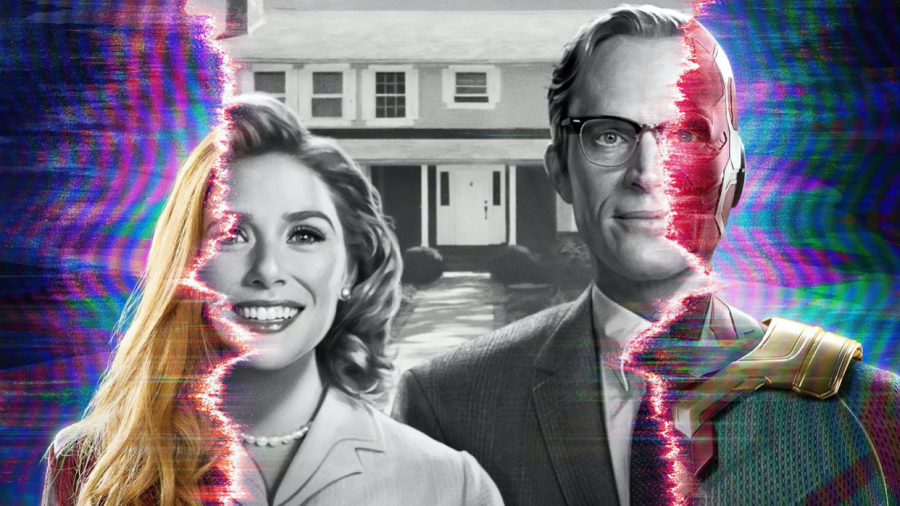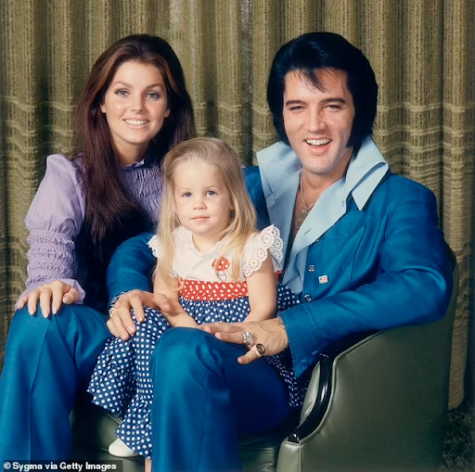WandaVision: An Analysis of Trauma & Grief
This photo features the show’s leads, Wanda Maximoff (left) and Vision (right) played by Elizabeth Olsen and Paul Bettany.
May 19, 2021
*THIS REVIEW INCLUDES SPOILERS*
When the trailer was first released for Disney’s next installment in the Marvel Cinematic Universe, many fans were perplexed yet intrigued by the uniqueness of the series. Although many were excited to give it a chance, others were apprehensive about this unfamiliar topic. I’ve seen many people quit after merely watching the first two episodes and miss out on this breathtaking series. If you were someone that did this, I’d strongly encourage you to go give it a chance before you read this article and experience its glory for yourself.
WandaVision has nine episodes, naturally separating every two or three in order to fit the common three-act structure we see in movies, television, and novels. This type of storytelling is comprised of a setup, confrontation, and resolution, (Maio). During most of these episodes, we see the show play out using sit-com style storylines to portray Wanda passing through the “Five Stages of Grief.” In short, this process begins with the denial of one’s loss, proceeds to anger, bargaining, and depression, and ultimately ends with acceptance. These steps give us a simple way of understanding the complex psychological experience that is grief, and how our minds cope with it. In WandaVision, we finally see the built-up trauma Wanda has endured over the course of her life.
Throughout the story, the audience gets to see Wanda find herself through her experiences. She has become many people’s favorite character, after seeing her thoughts and the immense obstacles she has faced since childhood. This allows people to empathize with her. Many people have lost loved ones, and this show is very relatable to those who have gone through similar experiences. In the end, WandaVision is about healing and moving on from these traumas with hope for what the future has to offer. So, let’s dive into how this show masterfully portrays the intricacies of grief and loss.
DENIAL
When someone experiences the loss of a loved one, it can be a very shocking and grueling experience. A lot of times, during the beginning stage of the grieving process, people tend to deny the tragedy in hopes of protecting themselves. It can be a struggle to accept the events that have occurred and it might be easier to just ignore them. We see Wanda do this throughout most of the show, but specifically in the first two episodes which are heavily influenced by the shows I Love Lucy, Bewitched, Dick Van Dyke, I Dream of Jeannie, and The Twilight Zone, (Salem). All of these shows have one thing in common: they are lighthearted, have a conflict that is resolved by the end of the episode, and the stakes are low. Wanda chooses this style for her made-up reality because it’s the exact opposite of her real life. The safety of her and her loved ones is constantly being tested and their lives are always on the line. Since Wanda joined the Avengers in Age of Ultron, her life has been nothing but painful, except for the time she spent with Vision.
After she had lost her whole family, she looked to him for comfort and companionship only to lose him too. Then, when she is blipped for five years after Thanos’ snap, she comes back after everyone has had time to grieve and move on without her. In a scene in the eighth episode of the series, Wanda says, “It’s just like this wave washing over me again and again. It knocks me down and when I try to stand up, it just comes for me again. And I can’t… It’s gonna drown me,” (‘Previously On…’). Being so young, Wanda has been faced with many obstacles, but not once has she been given a moment to catch her breath. This line is a perfect way to demonstrate that suffocating feeling of loss without ever dealing with it adequately. In response to all of this layered and unmanaged trauma, she accidentally creates this false world in hopes of recapturing the feeling of solace she had with Vision using an unhealthy coping mechanism. However, when people begin to infiltrate Westview, Wanda views it as an attack as it disrupts her fantasy and forces her to face the harsh reality she is trying so desperately to avoid facing. This leads us to our next step in the grieving process: anger.
ANGER
Wanda does not take kindly to people coming into Westview uninvited because it’s a reminder that everything she’s created in this town is fake and that one day she’ll have to process all this loss. Life has been cruel to Wanda. She has gone through more than anyone should have to in multiple lifetimes. However, she still deserves to have a happy ending, which is just what she is attempting to find with Westview. Unfortunately, it came at quite a hefty cost.
The people whom she has unintentionally taken prisoner in her town see her, once again, as a villain. This has been a common theme throughout Wanda’s story arc in the MCU and it’s frustrating for her to have people constantly view her in that light and it has also fueled the anger we see in the show. There is a specific scene in episode seven where Monica says to her, “don’t let [Hayward] make you the villain” to which Wanda replies, “maybe I already am,” (‘Breaking the Fourth Wall’). I think this line showcases how people misunderstanding Wanda has shaped her view of herself and others. She is angry at the world and at those who fail to see the pain she’s endured and only paint her as a shallow bad guy. In WandaVision we see the pent-up rage of this character come flowing out as she tries to seek her happy ending. Although Wanda does deserve to finally feel fulfilled and at peace with herself, she goes about it in the wrong way by harping on the past and asking: “what if things had gone differently…?”
BARGAINING
This extends into the next phase of grieving which is “bargaining.” This is a step in the mourning process where the person tries to “regain control” by “creating a lot of ‘what if’ and ‘if only’ statements,” (Holland). Over the course of the whole series, we see Wanda bargaining with the universe. She attempts to negotiate death by subconsciously creating a false Vision that allows her to play out the events of a world in which they both made it out alive in the end. Wanda gets to experience marriage, pregnancy, raising children, holidays and so many more joys of life that she would have otherwise been deprived of. But at the end of the day, none of this is real no matter how much she wishes it to be. Wanda even says so herself in a comment she makes to her children that says, “I am trying to tell you that there are rules in life, okay? We can’t rush aging just because it’s convenient. And we can’t reverse death. No matter how sad it makes us. Okay? Some things are forever,” (‘On a Very Special Episode…’). Here, we see Wanda speak to herself indirectly because she knows deep down that what she is doing in Westview is just a bandage over her wound. It’s not going to heal itself until she faces it head-on and stops trying to deny and hide from it. When she does become more aware of her actions and comes to terms with the fact that there is no way to avoid this loss, she enters a state of misery.
DEPRESSION
In episode seven, Wanda has completely lost all motivation to keep up with her facade. She is now experiencing the depression segment of grieving where the person is coming down from their anger and active bargaining and the emptiness is starting to settle in. This episode takes influence from sit-coms like The Office and Modern Family where the characters often talk to the camera and express their emotions that way, (Salem). Wanda expresses her depressive state by not getting dressed, taking care of her hair, staying in bed all day, and neglecting her children. She also shows apathy toward everything in her life, including Westview itself. When the 50s’, 70s’, and 2000s’ home decor begin to blend together, she doesn’t seem to be bothered by it too much. It’s clear she notices these odd changes in her home but is too depressed to care about it. In a scene where she speaks directly to the audience, we see her being very self-aware of her behavior and part in Westview for the first time. This tells us that she is on her way to fully accepting the deaths’ of her loved ones and can begin truly healing from them. This is a great metaphor for the way Wanda’s life has gotten overwhelming and out of control due to this grief that has her mental state in complete disarray. At the end of this episode, we find out that “Agnes”, really Agatha, has been messing with Wanda the whole time and plans to take her on a trip through her traumatic memories to finally discover how the town of Westview came to fruition.
ACCEPTANCE
During the penultimate episode of WandaVision, Wanda finally begins to embark on her journey of acceptance, the last stage of grief. In the final act of the story, Wanda travels through her mind and looks back on scarring, unforgettable memories that have shaped her as a person in a therapy-style type of way. It begins with the death of her parents and the near-death of her and Pietro in Sokovia where we find out the reason Wanda has such a deep connection to sit-coms is because they were something she watched with her family as a kid, becoming a comfort for her as an adult. It continues through to her time volunteering for Hydra where she unlocked her gifts and ends with her going to an empty plot in New Jersey where Vision had purchased a house deed for the two of them. Finally, we see Wanda actualize the town of Westview and a whole new Vision with her magic being fueled by her suppressed agony.
Now that Wanda has freed this concealed memory from her subconscious, she starts to understand herself and how she got to this point. She also finds out that there is a name for what she is: The “Scarlet Witch”. This comic book title reveal is a powerful parallel for Wanda’s self-discovery as this is the first time she is able to put together the intricate puzzle that is her past and is referred to by this name. With all of this new information about her identity and life experiences, Wanda is finally able to come to terms with all that she has done and been through. At the end of the series, Wanda makes the noble decision to let the people of Westview go and has no choice but to leave her family behind in the process. She flies off with hopes of learning more about the lore behind the “Scarlet Witch” and unlocking her true potential. Despite having to say goodbye to her family, Wanda doesn’t give up hope that one day they might see each other again because “what is grief, if not love persevering,” (‘Previously On…’).






